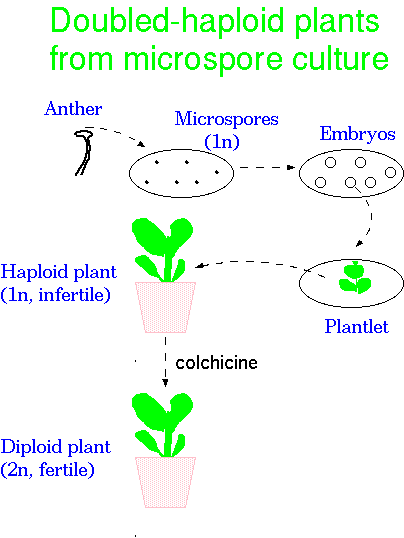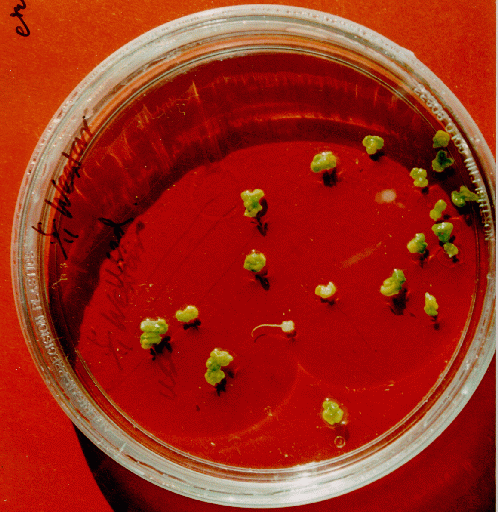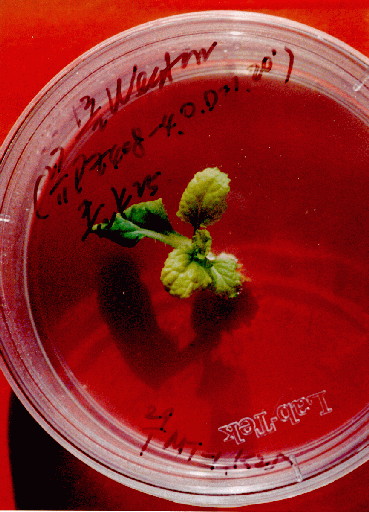
Haploidy is a general term designating individuals or tissues (in mosaics) that have somatic cells with a gametic chromosome number (N). In cases of polyploid series in which there are different species carrying multiples of the basic chromosome set (X) the term haploidy is subdivided into:
Haploids can be produced spontaneously or by induction. Spontaneous haploid production through asexual development as a haploid of an individual that should be diploid was discovered in Drosophila, salamander, newt, frogs, mouse, and chicken. Haploids in animal species are physiologically abnormal and die during embryogenesis.
Examples of spontaneous haploid production are found in a number of plant species including tomatoes, cotton, coffee, beets, barley, flax, coconut, pearl millet, rapeseed asparagus and wheat. In all, there are 36 species of 26 genera and 10 families in which haploidy occurred spontaneously.
Methods of haploid induction in plant species:
In a wide cross between Solanum nigrum using pollen from S. luteum, 7 of the 35 S. nigrum progeny were haploid. This mechanism is termed matroclinal pseudogamy in which the male gamete is required to stimulate embryo development. Then the embryo develops directly from the egg without fertilization. This technique is used as a breeding technique in potatoes.
Wheat, crossed to a wild species such as Aegilops caudata X Triticum astivum (pollen parent), and then backcrossed to wheat produces a high frequency (53%) of haploids.
Maize has been used as the pollen parent for wheat to produce high frequency of haploids. The maize chromosomes are found in varying numbers in the first cells of the embryo but are then selectively eliminated to leave only the wheat genomic complement.
In crosses between cultivated barley Hordeum vulgare
2x=14 with wild relative H. bulbosum, H. bulbosum
chromosomes are usually lost in the developing embryo. The yield
of haploids is relatively low: 11% to a high of 68%. The loss of
chromosomes is gradual so that 3-5 days after pollination, 40% of
dividing cells are haploid. After 11 days post pollination, 94%
are haploid.
| Table 4.7. Types and Frequencies of Progeny Obtained from Interspecific Crosses between Hordeum vulgare (V) and H. bulbosum (B) | ||||||||
|
|
|
|||||||
| Cross combination
(Female X Male) |
No. of plants | V
7 |
VV
14 |
VB
14 |
VBB
21 |
VVBB | Embryo | Endosperm |
| VV x BB | 1544 | 1517 | 26 | 1 | 1V:1B | 2V:1B | ||
| BB x VV | 35 | 35 | 1V:1B | 1V:2B | ||||
| VV x BBBB | 87 | 87 | 1V:2B | 2V:2B | ||||
| BBBB x VV | 6 | 6 | 1V:2B | 1V:4B | ||||
| VVVV x BB | 4 | 4 | 2V:1B | 4V:1B | ||||
| VVVV x BBBB | 79 | 76 | 3 | 2V:2B | 4V:2B | |||
| BBBB x VVVV | 34 | 34 | 2V:2B | 2V:4B | ||||
| Modified from Kasha, 1974. | ||||||||
Many mechanisms have been proposed for chromosome loss, including chromosome fragmentation, degradation of chromatin, lagging chromosomes or bridges, non-congressed chromosomes at metaphase or failure of chromosome migration to the anaphase poles. It may also be related to differences in duration of somatic cell cycles in two parents (asynchrony) as the somatic cycle is longer in H. bulbosum.
Plants are pollinated with irradiated pollen which has lost its ability to fertilize. The pollination stimulates the unfertilized eggs to parthenogenic development. Examples are found in various crops including tobacco, wheat, snapdragon, and Oenothera.
Selection of haploids can also be achieved by screening for poly-embryonic seed which are seeds with two or more embryos within the same seed coat. The embryos may be haploid or diploid. In the genus Capiscum (pepper), the frequency of twins is controlled by the genotype of the female parent. Through selection, it is possible to raise the percentage of twinning to several percent.
Anther and pollen culture is tissue culture method of production involving culturing of anthers. Haploids develop directly from pollen grains in culture, either through direct formation of embryos from pollen grains, or formation of callus and subsequent plant regeneration. This technique requires optimizing culture conditions which vary between species and between genotypes. Induction frequency can be high and the production time to mature plants of three to four months with direct development of homozygous individuals.
Monohaploids have one basic genome (x). Meiosis is very irregular with single homologs present. Chromosomes pair intra-genomically because ancient polyploidization events have left large portions of the genome duplicated. Pairing has been observed in rice, tomato, maize and barley in which synaptonemal complexes appear similar in nature to that found in diploids. Pairing of non-homologous chromosomes in normal diploids is probably evidence that the molecular mechanisms for pairing at zygotene act preferrentially when two chromosomes are nearly identical, as opposed to chromosomes which have diverged over time.
At metaphase I, the spindle is highly disorganised. At Anaphase I , the distribution of chromosomes to opposite poles is apparently random.
Polyhaploids can originate from autopolyploids or allopolyploids. Recall that in autopolyploids, all genomes (x) have the same origin AAAA. In allopolyploids, basic genomes are of different origin AABB. The classification of autopolyhaploids AA or allopolyhaploids AB can be made on pairing behaviour. Complete absence of pairing is an indication of allopolyhaploids. The occurrence of pairing in polyhaploids is indicative of some chromosomal relationship, homologous or homeologous.
Pairing in haploids is a way of observing ancient duplications. Homoeology describes partial homology during which some chromosome segments pair and some do not pair. Inter-genomic pairing between homolgous or homoeologous chromosomes takes precedence over intragenomic pairing.
Pairing occurs between partially homologous chromosomes of
allopolyhaploids. This has been observed in wheat, considered to
be an allopolyploid AABBDD. In wheat, the Ph1
(pairing-homeologous) locus on chromosome 5B encodes a gene
product which inhibits pairing between homeologous loci. Ph-
mutants have increased homeologous pairing. There is a similar
genetic control of chromosome pairing in other species such as
oats.
One of the major problems facing plant breeders is the simple
fact that offspring from a cross have a great deal of variability
for important traits such as winter hardiness. Tissue culture
makes it possible to create haploid plants, whose chromosome
numbers are then doubled to produce normal diploids, bearing two
identical copies of every gene.
| Anther tissue containing microspores are placed on tissue culture media, and grown to become haploid embroys. Embryos are transferred to individual plates and develop into plantlets. Plantlets are then transferred into soil. Seedlings are sprayed with colchicine, which causes chromosome doubling. When plants flower, the germline cells will be diploid. Offspring of doubled haploid plants are therefore more genetically uniform, for all important traits. Homozygosity allows direct selection of recessive characters and simplified gametic ratios. |
 |
 |
 |
| Canola (Brassica napus
) embryos regenerating from haploid microspores. Peijun Zhang, Ph.D. thesis University of Manitoba, 1998 |
Regenerating haploid plantlet. Peijun Zhang, Ph.D. thesis University of Manitoba, 1998 |
The word aneuploid describes cells, tissues and individuals having one or more whole chromosomes or segments of chromosomes absent from or in addition to a euploid complement. Aneuploids:
Aneuploidy is useful because it allows the analysis of meiotic phenomena and the construction of special genetic combinations.
As seen previously, plants seem to allow tremendous variation in genome size, and within a given species, many levels of ploidy are found in healthy plants. In fact, some tetraploids are heartier than their diploid counterparts. For example, commercially grown strawberries are octoploid. We will see in this section that just about every possible kind of aneuploidy is also tolerated in plants, often with little or no deleterious effect.
Animals are far less tolerant of aneuploidy. In particular, all but a few trisomies or tetrasomies cause spontaneous abortion. That is, developmental abnormalities are so severe that the embryo does not survive. The few exceptions are virtually all deleterious.
Interestingly, human cells in culture can grow with triploid or greater chromosomal complements. For example, human carcinoma cell lines such as SK-BR-3 can have 80 to 84 chromosomes, compared to the normal diploid complement of 46. (Source: American Type Culture Collection). The significance of this observation seems to be that aneuploidy in animals has less of an effect on the housekeeping functions of the cell, but a greater effect on the processes of development and differentiation.
Trisomic cells and tissues of individuals have
one or more extra chromosomes or chromosome segments as compared
to the euploid state.
The table below lists the most commonly-observed 2N+1 trisomies.
Note that other than sex chromosome trisomies, only three occur at
a high enough frequency in live births to be worth mentioning.
That is, all of the other trisomies occur in zygotes, but only a
few allow the embryo to survive to birth. Even for those that do
allow viable offspring, only a small percentage actually survive
to birth.
Hassold T, Hunt P (2001) To Err (Meiotically) is Human: The
Genesis of Human Aneuploidy. Nature Reviews Genetics
2:280-291.

It is also worth noting that the three trisomies that are tolerated are for smaller chromosomes. The larger the chromosome, the more genes will be present in an extra dose.
The fact that sex chromosome aneuploidies are tolerated is due to the special mechanisms that exist for dosage compensation in normal cells. That is, human cells normally have to be capable of functioning with either one or two copies of the X chromosome (XY or XX). In normal female diploid cells, one copy of the X chromosome is condensed and inactive, while the other copy is decondensed.
| Chromosome Constitution | Sex | Syndrome | Frequency in abortuses | Frequency of live births |
|---|---|---|---|---|
| XO | F | Turner's syndrome: short stature, webbed neck, streak gonads, sterile, heart defects common. | 1/18 | 1/3500 |
| XXY | M | Klinefelter's Syndrome: underdeveloped testes, infertile, some breast enlargement, mild delays in speech and language development and problems with reading. | 0 | 1/650 |
| XYY | M | Tall stature, long limbs, fertile, increased risk of learning disabilities and delayed development of speech and language skills, increased risk of behavioral, social, and emotional difficulties compared with their unaffected peers | ? | 1/1000 |
| XXX, XXXX, XXXXX | F | Taller than average, fertile, increased risk of learning disabilities and delayed development of speech and language skills (higher risk with each extra X chromosome). | 0 | 1/1400 for 47, XXX; less for others |
| Trisomy 21 | M/F | Down Syndrome: aberrant folding of eyelids, facial irregularities, stubby hands and feet, intellectual disability, cardiac malformation, peculiar pigmentation of eye, increased risk of hearing and vision problems. Avg. survival 16 years. | 1/40 | 1/800 |
| Trisomy 18 | M/F | Edward's syndrome: Severe abnormalities, avg. survival 6 months | 1/200 | 1/4500 |
| Trisomy 13 | M/F | Patau's syndrome: harilip, cleft palate, cerebral, ocular, and cardiac defects, avg. survival of 3 months | 1/33 | 1/14,500 |
| from Swanson CP, Merz T, Young WJ (1981) Cytogenetics. Prentice Hall Inc. Updated with information from NIH Genetics Home Reference. | ||||